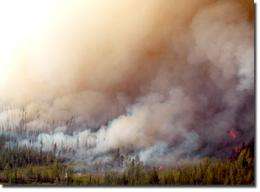Plants may affect the effect of wildfires

(PhysOrg.com) -- Rising temperatures may lead to more tinder-dry vegetation, but that doesn't mean there will be a higher risk for wildfires in a particular area.
It all depends on the type of vegetation. A new study on the cover of the May issue of Ecological Monographs shows that, in some cases, the types of plants growing in an area could override the effects of climate change on wildfire occurrence.
Lawrence Livermore National Laboratory scientist Tom Brown, along with Philip Higuera of Montana State University and colleagues, looked at the direct and indirect impacts of millennial-scale climate change on fire occurrence in the south-central Brooks Range in Alaska.
The team looked at historical fire occurrence by analyzing sediments found in the bottom of lakes.
Using the Lab's Center for Accelerator Mass Spectrometry, they carbon dated the deposits in the sediment and reconstructed fire occurrences from 15,000 B.C. to the present. Then they measured the amount of plant parts, such as fossil pollen, to figure out what type of vegetation dominated the area during the different time periods.
The conclusion: Fire frequencies coincided with changes in the type of vegetation in the area, more so than rising temperatures alone.
"If all we did was look at rising temperatures and ignore the vegetation in the area, that wouldn't be a good predictor of the likelihood of wildfires in a particular region," Brown said. "You have to look at the whole picture."
Although changing temperatures and moisture content set the stage for changes in wildfire frequency, they often can be trumped by changes in the distribution and abundance of plants.
Earlier studies have shown that the area burned across arctic and boreal regions will increase over the next century as climate change lengthens the fire season, decreases moisture and increases ignition rates. However, vegetation can alter the direct link between climate and fire by influencing the abundance, structure and moisture content of fuels across space and time, Brown said.
"There's a complex relationship between fuels and climate," he said. "Vegetation can have a profound impact on fire occurrences that are opposite or independent of climate's direct influence on fire."
In the recent study, the researchers found that changes in climate were less important than changes in vegetation. Despite a transition from a cool, dry climate to a warm, dry climate about 10,500 years ago, the researchers found a sharp decline in the frequency of fires. Their sediment cores from that time period revealed a vegetation change from flammable shrubs to fire-resistant deciduous trees.
"In this case, a warmer climate was likely more favorable for fire occurrence, but the development of deciduous trees on the landscape offset this direct climatic effect," Higuera said.
The research implies that the impacts of climate change on modern-day fire frequencies could be strongly mediated by changes in vegetation.
"This could give fire managers a good indication that vegetation can substantially alter the direct effects of climate change on fire occurrence," Brown said.
Source: Lawrence Livermore National Laboratory



















